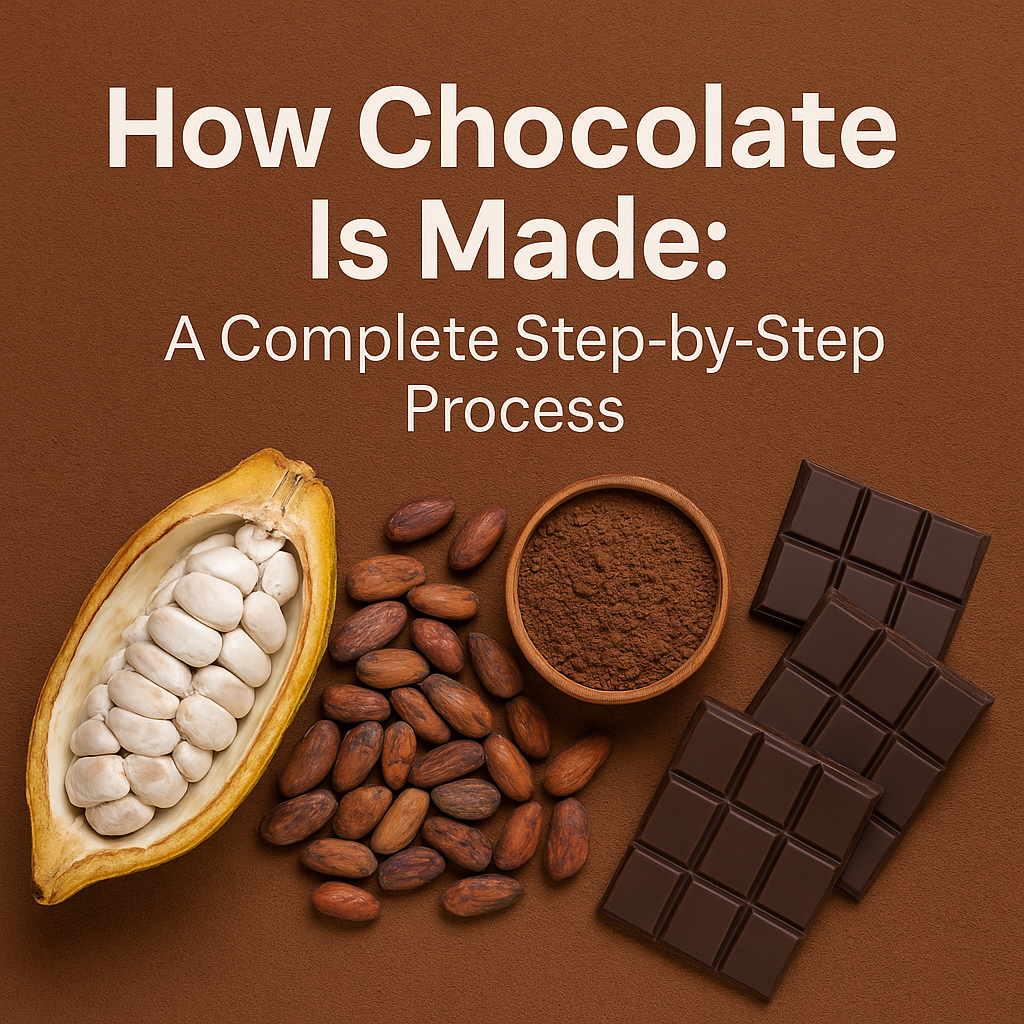Chocolate, a favorite treat around the world, has a long history that goes back thousands of years. It started as a special drink and became a popular sweet enjoyed everywhere. Learning how chocolate is made step by step helps us understand and enjoy it even more.
A Detailed History of Chocolate
Origins in the Amazon Basin
Chocolate begins with the cacao tree, which grows in the Amazon Basin in South America. New studies show cacao was first grown over 5,000 years ago in southern Ecuador. This changes older ideas that cacao started mainly in Mesoamerica. If you’re wondering where chocolate comes from, this is the real start.
Spread to Mesoamerica
From the Amazon, cacao spread north to early groups like the Olmecs around 1500 BCE. They made a bitter, foamy drink from cacao beans. Later, the Maya and Aztecs used cacao in ceremonies and everyday life. The Maya added spices to their chocolate drinks. The Aztecs valued cacao so much they even used the beans as money. Emperor Montezuma II drank large amounts of cacao daily.
Introduction to Europe
Spanish explorers brought cacao to Europe in the 1500s. Europeans sweetened the bitter drink and added flavors like vanilla, making it popular with royalty. In the 19th century, new inventions led to solid chocolate bars.
How Chocolate Is Made Step by Step: From Bean to Bar
1. Harvesting the Cacao Pods
Chocolate starts on cacao trees that grow in warm, tropical places. Workers pick cacao pods by hand, usually twice a year. Each pod contains 20 to 50 cacao beans covered in sweet pulp. If you search how are cacao beans harvested, this is the first step.
2. Fermentation
After picking, the beans and pulp are placed in shallow boxes to ferment for several days. Fermentation is very important because it starts the flavor development. The beans are stirred often to help fermentation happen evenly and reduce bitterness. This explains how chocolate gets its flavor early on.
3. Drying
Once fermented, the beans are spread out in the sun to dry. Drying lowers moisture to stop mold and prepares the beans for storage and shipping. Proper drying keeps the beans good quality, which is why drying cacao beans is a key step.
4. Roasting
The dried beans are roasted at about 120°C to 160°C. Roasting brings out the chocolate flavor by creating special chemical changes called Maillard reactions. This gives chocolate its smell and taste. If you’ve ever wondered how cocoa beans are roasted, this is the answer.
5. Winnowing
After roasting, the beans are cracked to remove their shells in a process called winnowing. What is left are the nibs, the edible part of the bean. Removing shells is important because shells taste bitter and can make chocolate gritty. Many people ask what is winnowing in chocolate making — now you know.
6. Grinding
Nibs are ground into a thick paste called chocolate liquor. Despite the name, there is no alcohol in it. This paste contains cocoa solids and cocoa butter. Grinding warms the paste, melting the fat and making it smooth. This is how chocolate is ground to prepare it for final stages.
7. Conching
Conching is a process where the chocolate liquor is mixed and heated for hours. This makes the chocolate smoother and better tasting by removing unwanted flavors and coating particles with cocoa butter. If you search what is conching in chocolate making, this explains it well.
8. Tempering
Tempering means cooling and warming the chocolate carefully to make the cocoa butter crystals line up. This step gives chocolate a shiny look and a firm snap when you break it. Good tempering is needed for perfect texture and appearance. Many people want to learn how to temper chocolate for a professional finish.
9. Molding and Cooling
Tempered chocolate is poured into molds to form bars or other shapes. The chocolate is then cooled to harden. Cooling must be done right to avoid spots or streaks on the chocolate.
10. Packaging
Once cooled, the chocolate is taken out of the molds and wrapped. Packaging protects the chocolate from heat, moisture, and odors, keeping it fresh and tasty for customers.
What Is White Chocolate and How Is It Made?
White chocolate is different from regular chocolate because it doesn’t contain cocoa solids, which give chocolate its color and strong flavor. Instead, white chocolate is made from cocoa butter, sugar, and milk solids. The cocoa butter comes from the cacao bean but lacks the dark cocoa particles. This gives white chocolate its creamy texture and sweet taste.
To make white chocolate, cocoa butter is mixed with sugar and milk, then melted, blended, and cooled into bars. Since it has no cocoa solids, it doesn’t have the typical chocolate flavor but remains rich and smooth.
Difference Between Dark and White Chocolate
Dark chocolate contains both cocoa solids and cocoa butter. It has a rich, slightly bitter taste and is darker in color. The higher the cocoa content, the more intense the flavor. Dark chocolate may also have little or no sugar added.
White chocolate, on the other hand, only contains cocoa butter, sugar, and milk solids. It’s pale or ivory in color and tastes sweeter and creamier because it lacks the bitter cocoa solids.
In summary, the main difference is that dark chocolate has cocoa solids, giving it the deep chocolate flavor and color, while white chocolate doesn’t, making it milder and sweeter.
Can We Make Pure Chocolate at Home?
Pure chocolate can be made at home, but it takes some special tools and patience. Pure chocolate means chocolate made directly from cacao beans without extra fillers or additives.
To do this, you need to roast cacao beans, crack and remove their shells, grind the nibs into a paste called chocolate liquor, then refine and temper it. While the steps are simple, achieving the right texture and flavor can be tricky without professional equipment.
Homemade pure chocolate is rewarding but requires practice to get smooth, well-tempered bars like the ones you buy in stores.
Why Chocolate Is So Loved Around the World
Chocolate is loved worldwide because it combines rich flavors with a smooth, creamy texture. It contains natural compounds like theobromine and small amounts of caffeine, which can boost mood and energy. Chocolate also releases chemicals in the brain linked to pleasure and happiness.
Also, chocolate can be eaten plain, mixed with nuts, fruit, or spices, or used in desserts and drinks. This variety means there’s a chocolate flavor for nearly everyone, making it one of the most popular treats around the globe.
Where Can I Find The Best Baking Chocolate?
Looking for the best baking chocolate in order to make your favourite brownies? You’re in luck! At EFA, we source premium, rich, and velvety chocolate that melts perfectly, giving your desserts a flawless and scrumptious taste every time. Check out our collection now!

